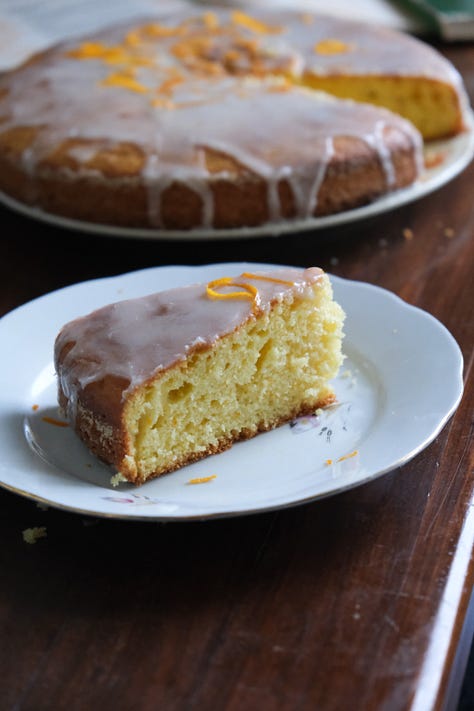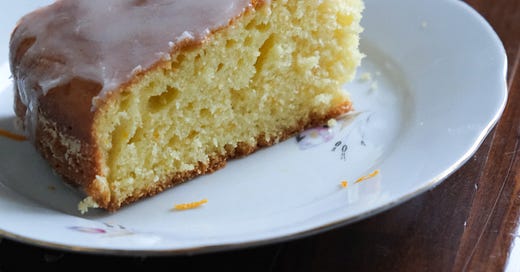An Orange Cake and Liguria: History, Scents, and Traditions in a Recipe
From gardens to alleyways, from orange groves to confectioneries: a brief journey through Liguria, guided by its oranges—plus, an exciting new guide in the making.
When I feel like taking a walk close to home but want to avoid the seafront, I head into the ancient alleyways further inland, where the paths are paved with red cobblestones and flanked by tall dry-stone walls. I love these hidden routes because they are free from cars, filled with silence, and—above all—because from behind those walls, the treetops emerge, hinting at secret gardens that fuel my imagination as I stroll.
Lemon and orange trees often peek over the walls, their branches heavy with sun-kissed fruit in winter or adorned with fragrant white blossoms in spring. Each time, without fail, I think about how lucky the owners of these gardens must be.
Last weekend, a friend gifted me a basket of oranges from her garden—the very same ones I often gaze at with curiosity and just a hint of envy. She had so many she didn’t know what to do with them.
I, on the other hand, knew exactly what to make: my beloved orange cake, known in Liguria as torta d’arancio or torta de çetron, a recipe I discovered in Codice della Cucina Ligure (Codex of Ligurian Cuisine) published in 1984.
This cake is sunshine in a bite—soft, fragrant, and kissed with the bright essence of Ligurian oranges. Light yet indulgent, it’s the kind of cake that lingers on the palate, perfect for slow mornings with coffee, afternoon breaks in the golden light, or as a simple pleasure at the end of a meal.
Oranges from home gardens, untreated and naturally grown, are essential for this recipe. You need the zest, and garden oranges are usually more flavorful and slightly more acid than store-bought ones. In short, they taste like real oranges, not sweetened water.
I love this recipe so much that I want to share it with you. You'll find it at the end of this newsletter (just before my big news). But first, let me tell you the fascinating story of oranges in Liguria.
Liguria and Oranges: A Centuries-Old Bond
If Ligurian gardens often hide orange and lemon trees behind their walls, it’s neither a coincidence nor a passing trend. Liguria, with its mild climate and the natural protection offered by the Alps, has been an ideal land for citrus cultivation for centuries—yes, just like Sicily.
Since the late Middle Ages, lemons, citrons, and oranges have been cultivated along the coastal terraces and in the gardens of noble villas.
By the 18th and 19th centuries, citrus production had become one of Liguria’s most important economic resources, with exports primarily to Northern Europe. Imagine: up to 30 million citrus were shipped abroad each year!
But did you know that in the labyrinth of caruggi (narrow alleyways) of Genoa’s historic center, there is a street called Vico dell’Arancio—Orange Alley? Its name is a direct reference to the presence and trade of citrus fruits in the city.
And there’s more. In the noble villas of Genoa during the 16th and 17th centuries, orange trees were not just fruit-bearing plants—they were also prized ornamental features. Citrus trees were carefully cultivated in terraced gardens or large terracotta pots, which were moved into greenhouses during winter. Their presence added color, fragrance, and an exotic touch to the aristocratic estates.
Charles Dickens, who stayed in Genoa in 1844 at Villa delle Peschiere—one of the city’s most magnificent residences—painted a vivid picture of the lush aristocratic gardens in his book Pictures from Italy:
"It stands [Villa delle Peschiere, ed.] on a height within the walls of Genoa, but aloof from the town: surrounded by beautiful gardens of its own, adorned with statues, vases, fountains, marble basins, terraces, walks of orange-trees and lemon-trees, groves of roses and camellias."
Moreover, traces of Liguria’s citrus heritage remain visible today especially in the district of Nervi, Genoa. Once a secluded enclave of grand noble villas nestled between Mount Sant'Ilario and the sea, this area was dotted with estates cultivated with olive trees and oranges—both enhancing the landscape and providing a valuable source of income.
Some of these historic villas, including Villa Gropallo, Villa Saluzzo Serra, Villa Grimaldi Fassio, and Villa Luxoro, had terraced gardens that are now part of the Parks of Nervi. But the legacy of citrus lives on: orange trees still thrive in private gardens and line the charming boulevards that lead down to the sea, offering glimpses of Liguria’s fragrant past.
Oranges: A Delicacy for the Palate
Oranges were not just a feast for the eyes or a source of wealth for the Genoese elite—they were also a culinary treasure. Genoa’s master confectioners, renowned for their exceptional candying techniques, became famous abroad for producing candied oranges and candied orange peels. The aristocracy enjoyed them as an after-dinner treat, while less affluent families saved up all year just to buy a handful to include in their Christmas pandolce.
If you want to taste authentic, artisanal candied oranges, head to Pietro Romanengo, Genoa’s historic confectionery, founded in 1780. And if you’re a fan of chocolate-covered orange peels, I highly recommend those from the legendary chocolate shop Romeo Viganotti.
Liguria’s Unique orange Variety: Pernambucco
Liguria even boasts its own native variety of orange: the Arancio Pernambucco, mainly cultivated in the western part of the region. With its thick, rugged peel, its pulp is sweet and juicy, yet slightly tangy. Its early ripening makes it a rare gem in Italy’s citrus landscape.
Now, It’s Time to Bake!
After this little journey through Liguria’s orange groves, you simply must try my orange cake.
Let the zest perfume your kitchen, the batter glow with citrus warmth, and the first bite transport you to an old Ligurian villa, where oranges ripen behind stone walls and the sea murmurs in the distance 🍊✨.
And if you’re planning a trip to Genoa, visit the places I’ve mentioned and let yourself be enchanted by the scent of citrus in the air!
TORTA DE ÇETRON – ORANGE CAKE
Ingredients:
300 g (2 ½ cups) all-purpose flour
150 g (¾ cup) sugar
3 eggs
5 untreated oranges, their juice and zest
1 tablespoon bitter orange blossom water
100 g (7 tablespoons) butter
16 g (about 2 ½ teaspoons) baking powder
A pinch of salt
Preparation:
Beat the eggs with the sugar until pale and airy. Add the sifted flour and mix.
Grate the zest of the oranges, releasing their essence, and fold it gently into the batter.
Stir in the orange blossom water, an additional drop of floral perfume, and the freshly squeezed juice of the oranges (ab. 250ml/1 cup)
Melt the butter until it turns silky, then blend it into the mixture along with the baking powder and a pinch of salt.
Pour the batter into a buttered pan (22 cm diameter - 8 inch) and bake at 180°C (350°F) for about 40 minutes, until the surface is golden and fragrant.
Once baked, for any extra citrous soul, pierce the warm cake and drizzle with a touch of fresh orange juice to let it soak in.
For the final touch, mix 250 g powdered sugar with just enough orange juice to create a delicate glaze—one that drips slowly, like honey from a spoon. A sprinkle of orange zest on top completes this little ode to Liguria.



Do you bake with oranges?
Exciting News: My Genoa Food Guide is Coming!
Before I say goodbye, I want to give you a sneak peek at a project I’ve been working on for the past few months: my Genoa Food Guide!
After 10 years of writing about Genoa’s gastronomy, it’s time to put all my knowledge into one guide.
It will be a complete collection of my favorite foodie spots in Genoa, with descriptions and personal recommendations on what to buy, taste, order, and drink in each place. An interactive map you will download on your smartphone, directly linked with google maps for easily orientating in the city!
Where can we taste the best freshly baked focaccia? And the best gelato if it’s a hot summer afternoon? For an aperitivo open-air at sunset where should we go? No more foodie doubts!
Stay tuned—next newsletter, I’ll reveal all the details! 🍊✨








Thank you, Erica for all of the delicious recipes and interesting information that you have shared. This is an amazing cake! I am better at pasta and sauces than baking, but this brings that same smile to my face. I thought that you may be interested in hearing that I made one version using 3/4 tsp Fiori di Sicilia in place of the orange blossom water. Wow! An amazing option to try, if you feel creative sometime. Your recipe remains outstanding and worth everyone's time in making it!
Lovely reading about the oranges of Liguria! I am going to make this cake and one day, I hope to visit this lovely area, until then, your writings are a window through which I enjoy looking. ❤️ Thank you so much!